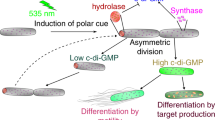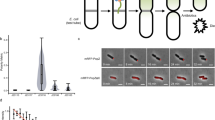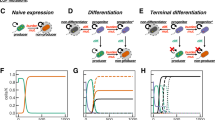Abstract
We describe a synthetic genetic circuit for controlling asymmetric cell division in Escherichia coli in which a progenitor cell creates a differentiated daughter cell while retaining its original phenotype. Specifically, we engineered an inducible system that can bind and segregate plasmid DNA to a single position in the cell. Upon cell division, colocalized plasmids are kept by one and only one of the daughter cells. The other daughter cell receives no plasmid DNA and is irreversibly differentiated from its sibling. In this way, we achieved asymmetric cell division through asymmetric plasmid partitioning. We then used this system to achieve physical separation of genetically distinct cells by tying motility to differentiation. Finally, we characterized an orthogonal inducible circuit that enables the simultaneous asymmetric partitioning of two plasmid species, resulting in cells that have four distinct differentiated states. These results point the way toward the engineering of multicellular systems from prokaryotic hosts.
This is a preview of subscription content, access via your institution
Access options
Access Nature and 54 other Nature Portfolio journals
Get Nature+, our best-value online-access subscription
$29.99 / 30 days
cancel any time
Subscribe to this journal
Receive 12 print issues and online access
$259.00 per year
only $21.58 per issue
Buy this article
- Purchase on Springer Link
- Instant access to full article PDF
Prices may be subject to local taxes which are calculated during checkout





Similar content being viewed by others
Data availability
The datasets generated and analyzed during the current study are available from the corresponding author upon reasonable request. All plasmids generated during this study are available on Addgene.
References
Hasty, J., McMillen, D. & Collins, J. J. Engineered gene circuits. Nature 420, 224–230 (2002).
Sprinzak, D. & Elowitz, M. B. Reconstruction of genetic circuits. Nature 438, 443–448 (2005).
Gardner, T. S., Cantor, C. R. & Collins, J. J. Construction of a genetic toggle switch in Escherichia coli. Nature 403, 339–342 (2000).
Stricker, J. et al. A fast, robust and tunable synthetic gene oscillator. Nature 456, 516–519 (2008).
Basu, S., Gerchman, Y., Collins, C. H., Arnold, F. H. & Weiss, R. A synthetic multicellular system for programmed pattern formation. Nature 434, 1130–1134 (2005).
Danino, T., Lo, J., Prindle, A., Hasty, J. & Bhatia, S. N. In vivo gene expression dynamics of tumor-targeted bacteria. ACS. Synth. Biol. 1, 465–470 (2012).
Lu, T. K. & Collins, J. J. Engineered bacteriophage targeting gene networks as adjuvants for antibiotic therapy. Proc. Natl Acad. Sci. USA 106, 4629–4634 (2009).
Xie, Z., Wroblewska, L., Prochazka, L., Weiss, R. & Benenson, Y. Multi-input RNAi-based logic circuit for identification of specific cancer cells. Science 333, 1307–1311 (2011).
Kotula, J. W. et al. Programmable bacteria detect and record an environmental signal in the mammalian gut. Proc. Natl Acad. Sci. USA 111, 4838–4843 (2014).
Masiello, C. A. et al. Biochar and microbial signaling: production conditions determine effects on microbial communication. Environ. Sci. Technol. 47, 11496–11503 (2013).
Levskaya, A. et al. Engineering Escherichia coli to see light—these smart bacteria ‘photograph’ a light pattern as a high-definition chemical image. Nature 438, 441–442 (2005).
Basu, S., Mehreja, R., Thiberge, S., Chen, M. T. & Weiss, R. Spatiotemporal control of gene expression with pulse-generating networks. Proc. Natl Acad. Sci. USA 101, 6355–6360 (2004).
Payne, S. et al. Temporal control of self-organized pattern formation without morphogen gradients in bacteria. Mol. Syst. Biol. 9, 697 (2013).
Sohka, T., Heins, R. A. & Ostermeier, M. Morphogen-defined patterning of Escherichia coli enabled by an externally tunable band-pass filter. J. Biol. Eng. 3, 10 (2009).
Danino, T., Mondragon-Palomino, O., Tsimring, L. & Hasty, J. A synchronized quorum of genetic clocks. Nature 463, 326–330 (2010).
Prindle, A. et al. A sensing array of radically coupled genetic ‘biopixels’. Nature 481, 39–44 (2012).
Chen, Y., Kim, J. K., Hirning, A. J., Josic, K. & Bennett, M. R. Emergent genetic oscillations in synthetic microbial consortia. Science 349, 986–989 (2015).
Balagadde, F. K., You, L. C., Hansen, C. L., Arnold, F. H. & Quake, S. R. Long-term monitoring of bacteria undergoing programmed population control in a microchemostat. Science 309, 137–140 (2005).
Chiba, S. Notch signaling in stem cell systems. Stem Cells 24, 2437–2447 (2006).
Reik, W., Dean, W. & Walter, J. Epigenetic reprogramming in mammalian development. Science 293, 1089–1093 (2001).
Fatica, A. & Bozzoni, I. Long non-coding RNAs: new players in cell differentiation and development. Nat. Rev. Genet. 15, 7–21 (2014).
Takahashi, K. & Yamanaka, S. Induction of pluripotent stem cells from mouse embryonic and adult fibroblast cultures by defined factors. Cell 126, 663–676 (2006).
Atkinson, M. R., Savageau, M. A., Myers, J. T. & Ninfa, A. J. Development of genetic circuitry exhibiting toggle switch or oscillatory behavior in Escherichia coli. Cell 113, 597–607 (2003).
Thattai, M. & van Oudenaarden, A. Intrinsic noise in gene regulatory networks. Proc. Natl Acad. Sci. USA 98, 8614–8619 (2001).
Gupta, C., Lopez, J. M., Ott, W., Josic, K. & Bennett, M. R. Transcriptional delay stabilizes bistable gene networks. Phys. Rev. Lett. 111, 058104 (2013).
Balazsi, G., van Oudenaarden, A. & Collins, J. J. Cellular decision making and biological noise: from microbes to mammals. Cell 144, 910–925 (2011).
Egbert, R. G. & Klavins, E. Fine-tuning gene networks using simple sequence repeats. Proc. Natl Acad. Sci. USA 109, 16817–16822 (2012).
Friedland, A. E. et al. Synthetic gene networks that count. Science 324, 1199–1202 (2009).
Baumgart, L., Mather, W. & Hasty, J. Synchronized DNA cycling across a bacterial population. Nat. Genet. 49, 1282–1285 (2017).
Nunez, I. N. et al. Artificial symmetry-breaking for morphogenetic engineering bacterial colonies. ACS. Synth. Biol. 6, 256–265 (2017).
Toro, E., Hong, S. H., McAdams, H. H. & Shapiro, L. Caulobacter requires a dedicated mechanism to initiate chromosome segregation. Proc. Natl Acad. Sci. USA 105, 15435–15440 (2008).
Gerdes, K., Moller-Jensen, J. & Bugge Jensen, R. Plasmid and chromosome partitioning: surprises from phylogeny. Mol. Microbiol. 37, 455–466 (2000).
Schumacher, M. A. Structural biology of plasmid partition: uncovering the molecular mechanisms of DNA segregation. Biochem. J. 412, 1–18 (2008).
Tran, N. T. et al. Permissive zones for the centromere-binding protein ParB on the Caulobacter crescentus chromosome. Nucleic Acids Res. 46, 1196–1209 (2018).
Mierzejewska, J. & Jagura-Burdzy, G. Prokaryotic ParA–ParB–parS system links bacterial chromosome segregation with the cell cycle. Plasmid 67, 1–14 (2012).
Debaugny, R. E. et al. A conserved mechanism drives partition complex assembly on bacterial chromosomes and plasmids. Mol. Syst. Biol. 14, e8516 (2018).
Livny, J., Yamaichi, Y. & Waldor, M. K. Distribution of centromere-like parS sites in bacteria: insights from comparative genomics. J. Bacteriol. 189, 8693–8703 (2007).
Gottesman, S., Roche, E., Zhou, Y. & Sauer, R. T. The ClpXP and ClpAP proteases degrade proteins with carboxy-terminal peptide tails added by the SsrA-tagging system. Genes Dev. 12, 1338–1347 (1998).
Yarmolinsky, M. Transcriptional silencing in bacteria. Curr. Opin. Microbiol. 3, 138–143 (2000).
Kyte, J. & Doolittle, R. F. A simple method for displaying the hydropathic character of a protein. J. Mol. Biol. 157, 105–132 (1982).
Cranfill, P. J. et al. Quantitative assessment of fluorescent proteins. Nat. Methods 13, 557–562 (2016).
Lu, M. et al. Helix capping in the GCN4 leucine zipper. J. Mol. Biol. 288, 743–752 (1999).
Yanisch-Perron, C., Vieira, J. & Messing, J. Improved M13 phage cloning vectors and host strains: nucleotide sequences of the M13mp18 and pUC19 vectors. Gene 33, 103–119 (1985).
Lee, C., Kim, J., Shin, S. G. & Hwang, S. Absolute and relative QPCR quantification of plasmid copy number in Escherichia coli. J. Biotechnol. 123, 273–280 (2006).
Meacock, P. A. & Cohen, S. N. Partitioning of bacterial plasmids during cell division: a cis-acting locus that accomplishes stable plasmid inheritance. Cell 20, 529–542 (1980).
Chawla, R., Ford, K. M. & Lele, P. P. Torque, but not FliL, regulates mechanosensitive flagellar motor-function. Sci. Rep. 7, 5565 (2017).
Schumacher, M. A., Piro, K. M. & Xu, W. Insight into F plasmid DNA segregation revealed by structures of SopB and SopB–DNA complexes. Nucleic Acids Res. 38, 4514–4526 (2010).
Litcofsky, K. D., Afeyan, R. B., Krom, R. J., Khalil, A. S. & Collins, J. J. Iterative plug-and-play methodology for constructing and modifying synthetic gene networks. Nat. Methods 9, 1077–1080 (2012).
Calos, M.P. DNA sequence for a low-level promoter of the lac repressor gene and an ‘up’ promoter mutation. Nature 274, 762–765 (1978).
Shis, D. L. & Bennett, M. R. Library of synthetic transcriptional AND gates built with split T7 RNA polymerase mutants. Proc. Natl Acad. Sci. USA 110, 5028–5033 (2013).
Acknowledgements
We are especially grateful to L. Shapiro (Stanford) and C. Jacobs-Wagner (Yale) for providing plasmids and to K. Fahrner and H. Berg (Harvard) for her help in supplying and consulting on strain HCB84. This work was funded by the Defense Advanced Research Projects Agency Biological Technologies Biological Controls Program, award no. HR0011-17-2-0012 (approved for public release; distribution is unlimited) (M.R.B. and O.A.I.); the National Science Foundation through the joint NSF–National Institute of General Medical Sciences Mathematical Biology Program grant DMS-166290 (M.R.B.); the Welch Foundation grants C-1729 (M.R.B.) and C-1995 (O.A.I.); and the National Institutes of Health, grant R01GM117138 (M.R.B.).
Author information
Authors and Affiliations
Contributions
M.R.B., O.A.I. and S.M. conceived of the study. S.M., D.L.S. and S.P.B. performed experiments, and S.M. analyzed the data. M.R.B., O.A.I. and J.C. oversaw the project. All authors wrote the manuscript.
Corresponding author
Ethics declarations
Competing interests
The authors declare no competing interests.
Additional information
Publisher’s note: Springer Nature remains neutral with regard to jurisdictional claims in published maps and institutional affiliations.
Supplementary information
Supplementary Information
Supplementary Figures 1–8 and Supplementary Tables 1 and 2
Rights and permissions
About this article
Cite this article
Molinari, S., Shis, D.L., Bhakta, S.P. et al. A synthetic system for asymmetric cell division in Escherichia coli. Nat Chem Biol 15, 917–924 (2019). https://doi.org/10.1038/s41589-019-0339-x
Received:
Accepted:
Published:
Issue Date:
DOI: https://doi.org/10.1038/s41589-019-0339-x



